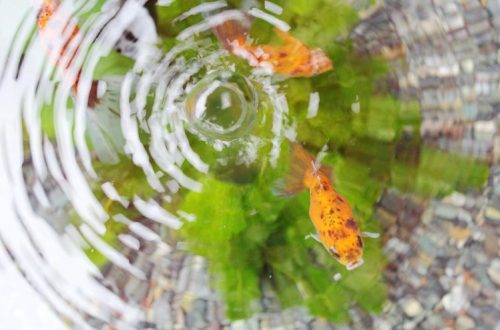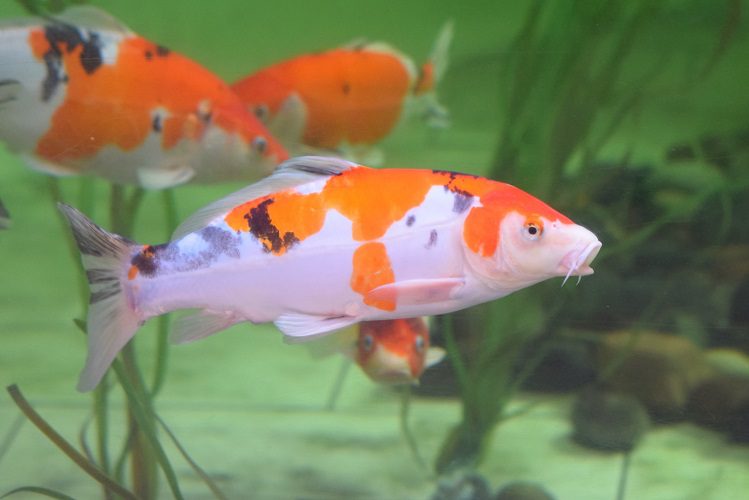
The largest and smallest aquarium fish
Tiny aquarium fish captivate us with their playful dance in the aquarium. Large aquarium fish are like the eighth wonder of the world, they are often perceived as real family members, as if it were not a fish, but a dog or cat. Today we will talk about large fish and their miniature relatives.
- Koi carps
Breeders have given koi carps more than twenty amazing colors. More often they are bred in ponds in regions with a warm climate. In Japan, koi pond breeding has become a very respected hobby.
But if you wish, these beauties can be brought into your aquarium if its volume is at least 500 liters. In a spacious pond, some varieties of koi grow up to 130 centimeters. Aquarium individuals reach 90-100 centimeters in length. They can rightfully be called one of the largest aquarium fish.
Koi are pond fish. Small they look great in aquariums, but for adult carp, the best place is a garden pond.
Koi are very sensitive to water quality, make sure that the amount of nitrogen compounds in the aquarium remains at zero. These fish are suitable for water temperatures from 15 to 30 degrees. Acidity should be maintained in the region of 6,5-8,5, and hardness – from 4 to 10.

- armored pike
A large toothy predator that prefers live food often lives not in home aquariums, but in oceanariums. All this we can say about the armored pike. If you decide to keep this fish at home, you will need a really large aquarium. From 200 to 500 liters per individual.
In the aquarium, the armored pike can grow up to 60 centimeters. In the wild, some individuals manage to grow up to three meters in length. It is desirable that the pike live alone in the aquarium. She is able to show aggression against relatives, and intraspecific aggression. Only large catfish can keep her company, but then the aquarium should also be huge.
The armored pike has thick scales, an elongated jaw, and sharp teeth. The character is aggressive, putting your hands in an aquarium with this fish, frankly, is not safe. If you decide to diversify the diet of the ward with specialized dry food, carefully lower it into the water and hold it with tweezers, because the fish will not pick up food from the bottom. And the armored pike loves to eat very much, the young are fed once every two days. For adults, two feedings per week are sufficient.
He likes cool water, from 18 to 20 degrees, the acidity of the water is at the level of 6-8, the hardness is 5-20. Armored pike need rich, dense flora in an aquarium so that they can hide in plants.
There are several ornamental varieties of armored pike. The photo shows a young spotted armored pike. In a spacious aquarium, it can grow up to 1,2 meters.

- Pterygoplicht
The peaceful Pterygoplicht catfish will be a real discovery for novice aquarists who want to get a special fish that is not too demanding to care for. Pterygoplichts in early childhood are similar to ancistrus, but then grow in length to more than 50 centimeters. A recognizable fin with more than ten rays flaunts on their back. For one pterygoplicht, an aquarium with a volume of 270-300 liters is suitable. A couple of pterygoplichts need a more spacious aquadom, about 400 liters.
Pterygoplicht, although distinguished by its impressive size, loves to clean up no less than its “younger brother” ancistrus. It is necessary to distinguish between brocade and leopard pterygoplicht. The base in brocade color is light brown or yellowish, but the whole body is densely covered with dark spots. The leopard pterygoplicht (pictured) has a very light base color, but the entire pterygoplicht is covered with dark spots, almost like a leopard. Leopards, even in adulthood, are slightly smaller than their brocade counterparts.
These aquarium nurses are suitable for a water temperature of 23-27 degrees, acidity in the region of 6,5-7,5, and hardness up to 15.
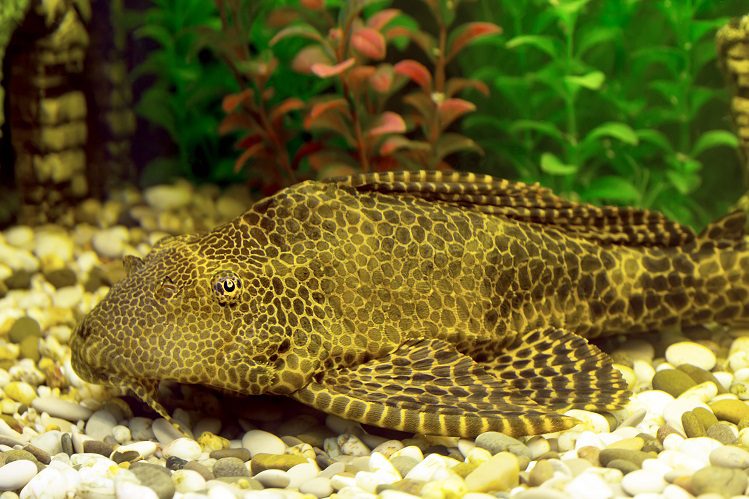
- Somik corridoras panda
Panda catfish are one of the representatives of the huge family of armored catfish corridors adored by aquarists. But their miniature size and charming appearance left us no choice, we will talk about panda corridors.
An adult can grow up to five centimeters in length, but among the panda corridors there are many who have grown to two and a half or three centimeters and decided to stop there. They love a good company, so you need to settle them in a flock of three to five individuals, no less. A suitable aquarium volume for such a company is from 40 to 50 liters. If these peaceful schooling fish live in a large aquarium, tetras, zebrafish, other types of peaceful catfish, labyrinth fish, dwarf cichlids will surely make friends with them.
But why are they called panda? The body of the catfish can be white or slightly pinkish, three black spots attract attention in the color. One starts at the top of the head and covers both eyes, just like the black circles around a panda’s eyes. Another dark spot can be seen on the dorsal fin. The third is at the base of the tail. These armored catfish have two rows of plates on the body that overlap each other. They also have three pairs of whiskers and sharp teeth for protection from adversity.
To keep the panda corridor cozy in your tank, keep the temperature at 22 degrees, but a temperature of 20 to 25 degrees is also acceptable. The acidity of the water must be maintained at a level of 6 to 7,4. Hardness should be between 1 and 17.
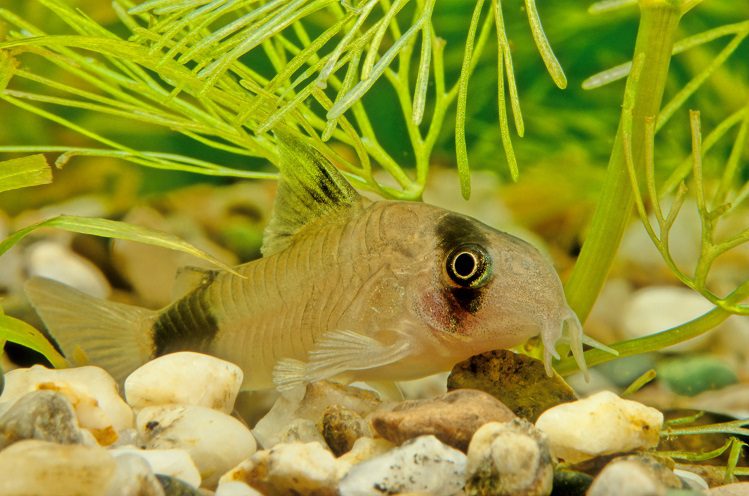
- Barbus cherry
Cherry barbus is a very beautiful name. But not all individuals you meet will be a bright cherry hue. Males have a more intense red color. But in females, the body is usually not bright cherry, but silver-olive, the fins are yellow.
Cherry barbs have an oblong, slightly laterally flattened body, from about two or two and a half to four centimeters long.
These tiny representatives of the carp family are unpretentious and peaceful. They get along well with other barbs (for example, yellow barbs), tetras, catfish, thorns and gourami. It is recommended to keep cherry barbs in a flock of seven to ten fish. Keep in mind that they love to hide in thickets of plants.
Barbs like the water temperature to be between 22-34 degrees. Maintain the acidity of the water at a level of 6,5-7,0, hardness – up to 15.

- Guppy Endler
One of the smallest aquarium fish in the world is the Endler guppy. In length, male Endler guppies grow up to two and a half centimeters. Pictured is a natural male. Females are slightly larger, up to four centimeters in length, their color is very restrained: gray-silver or golden, sometimes with a couple of small color spots.
An aquarium with a volume of 20 liters for a flock of six to seven Endler guppies is just right. If you start a smaller flock, then these fish can also be placed in fashionable cube aquariums with a volume of about 15 liters, but no less. For a seasoned aquarist, a tiny fish nano aquarium is an opportunity to try out a new format of aquarium, and for a beginner, it is a chance to try their hand at a new hobby, because a small aquarium will not cause much trouble. Endler’s guppies also look great in herbal aquariums.
These peaceful crumbs will suit the water temperature from 20 to 28 degrees. Comfortable acidity level – from 6,5 to 8,5, hardness – up to 25.
Endler’s guppies breed quickly, for this they do not need any special conditions. If you do not want to increase the number of inhabitants of the underwater world, it is better to immediately purchase only male Endler guppies.
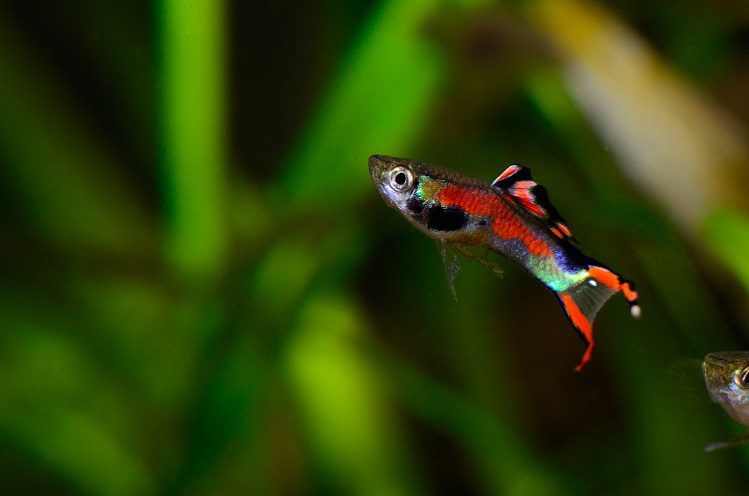
Remember the basic rules for keeping different types of fish together.
It is important to take into account the compatibility of fish in temperament and size.
Consider the necessary water parameters, the temperature in the aquarium should be comfortable for all its inhabitants.
Avoid crowding the aquarium and crowds at the bottom or in the upper layers of the water. If the same panda corridors are located closer to the bottom, they can be accompanied by neons, cherry barbs and zebrafish. Danios tend to stay closer to the surface of the water, while Neons and Cherry Barbs prefer to swim somewhere in between.
We wish your aquarium wards to feel great and give you only positive emotions!



